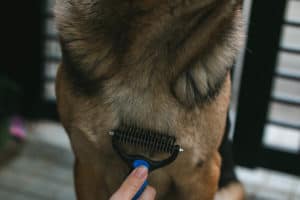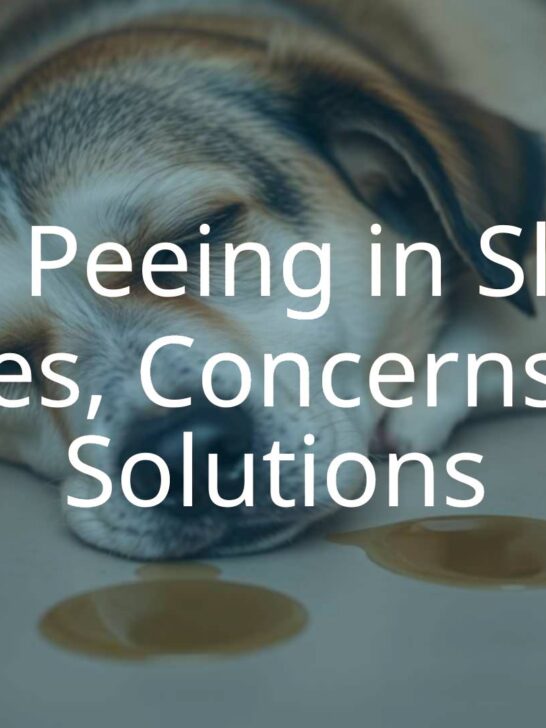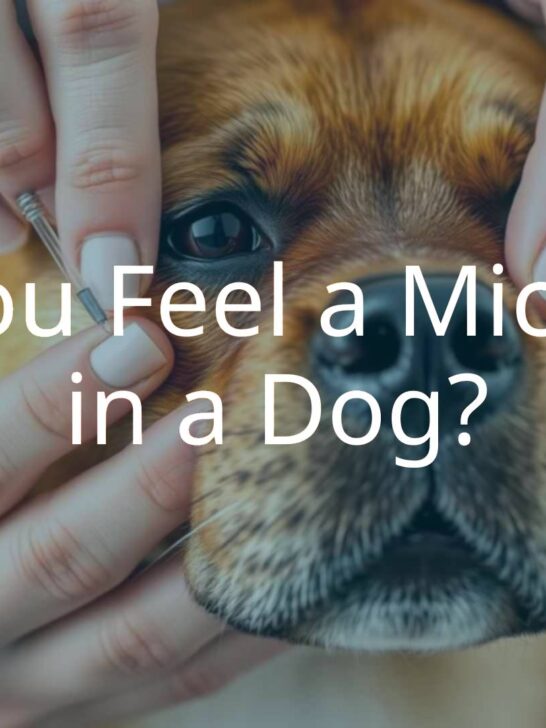Smegma in Dogs: What Is It and When to Worry
If you’ve noticed a yellowish or greenish fluid around your dog’s genital area, especially if you have a male dog, you might wonder, “What is smegma in dogs?” Smegma is a normal body secretion made up of dead skin cells, natural oils, and other fluids. Its main job is to keep the genital area lubricated and prevent irritation. Smegma by itself isn’t dangerous. But if you see a sudden increase, a bad smell, or changes in color or texture, it may mean there’s an infection or other health issue. Knowing what’s normal and what’s not is important for keeping your dog comfortable and healthy.
This article explains what smegma is, what it should look like, why dogs produce it, when to worry, and how to care for your dog’s genital area. You’ll learn about cleaning, when to call your vet, and tips for keeping your dog healthy.

What Is Smegma in Dogs?
Smegma is a common and usually harmless substance found in dogs, mostly males. It’s a mix of skin cells and oils that acts as a natural lubricant for your dog’s genitals. It keeps these sensitive areas moist and protects them from rubbing and irritation.
Both male and female dogs can produce smegma, but it’s usually seen more in males. In females, it appears in much smaller amounts. Knowing what’s normal for your dog helps you spot problems early.
Dog Anatomy: Penis and Prepuce
The prepuce is the skin sheath that covers the non-erect penis in male dogs. The penis inside has a mucous layer-similar to tissue inside your mouth-which naturally looks shiny and pink. Dogs also have a bone in their penis called the os penis, which makes it firm even when not aroused. When excited, the bulbus glandis (a swelling at the base of the penis) becomes noticeable. The prepuce’s job is to protect the penis, keeping it from drying out or being hurt. Smegma builds up naturally inside this area.
Normal Smegma: Color and Amount
Normal smegma is small in amount and is usually yellowish-white or slightly greenish. Its texture is like mucus. Some healthy dogs produce so little that you barely notice it. Others might have more, sometimes leaving drops on the hair around the prepuce. Normal smegma does not smell. If you notice a bad odor, it’s a warning sign to check things further.
| Appearance | What’s Normal | When to Worry |
|---|---|---|
| Color | Yellow-white, light green | Dark yellow, brown, red, or pus-like |
| Amount | Few drops or light coating | Large, frequent, or sudden increase |
| Odor | None | Foul or strong smell |
Is Smegma Harmful?
Smegma itself is not dangerous and actually helps keep the penis and prepuce clean by trapping dirt and old cells. Most healthy dogs handle this on their own. However, if smegma builds up too much or bacteria multiply, it can lead to an infection. Signs of infection include bad smell, color changes, or soreness. If untreated, it could lead to swelling, pain, or urinary problems.
Why Do Dogs Produce Smegma?
Smegma helps keep your dog’s genitals lubricated and protects the skin. The penis sits inside the prepuce in a warm, moist area, which causes natural oils, dead skin, and fluid to collect. This is normal. Hormones like testosterone, especially in intact (not neutered) males, also increase the amount produced. Some breeds or individual dogs make more than others.
Causes of Smegma in Male Dogs
- Prepuce Structure: The penis is enclosed, so fluids and cells collect naturally.
- Hormones: Intact males have higher testosterone and usually produce more smegma.
- Hygiene: Poor cleaning can increase buildup and cause bacteria to grow.
- Health problems: Conditions like diabetes or immune issues can lead to more smegma or infections.
Intact vs. Neutered Dogs
| Dog Type | Smegma Production |
|---|---|
| Intact (Not Neutered) | High |
| Neutered | Low |
Neutering reduces hormone levels, so smegma often decreases, but some is still normal.
Symptoms of Smegma Problems in Dogs
While normal smegma is harmless, too much or changes to its look or smell can mean there’s a problem. Be on the lookout for:
- Increase in discharge-thicker, more frequent, or different color
- Redness or swelling around the prepuce or penis
- Bad smell
- Your dog licking or biting the area more than usual
- Pain or discomfort, such as whining when touched
- Trouble peeing, or blood in urine
- General changes in behavior, like being tired or eating less
Risks and Complications
If smegma builds up and gets infected, more serious problems can happen:
- Bacterial infections that cause foul smell and pain
- Balanoposthitis – swelling and sore penis/prepuce
- Problems urinating because of swelling or pain
- More serious issues like fever, spread of infection, or exposure of the penis (paraphimosis), which is an emergency
When to Contact Your Vet
Watch for these warning signs. If you see any of the following, contact your vet:
- Large sudden increase in smegma
- Unusual color (brown, bloody, thick pus)
- Bad odor
- Visible pain or swelling
- Pain or problems when urinating
- Penis protruding and not retracting (paraphimosis)
- Signs your dog is generally unwell (fever, lethargy, won’t eat)
How Vets Diagnose Smegma Problems
Your vet will check the area and may run these tests:
- Microscopic examination and culture of smegma (to check for infection)
- Urine test (to check for urinary infection)
- Blood tests (to check general health and hormone levels)
- X-rays or ultrasound (if there may be stones or prostate issues)
Treatment Options
Based on the findings, treatment may include:
- Antibiotics for infections
- Anti-inflammatories to reduce swelling and pain
- Topical cleansers or ointments
- Cleaning/flushes of the area (done by your vet or with instruction)
- Treatments for underlying issues (urinary tract, prostate, or hormonal problems)
In serious cases (like paraphimosis), urgent care may involve lubricants or minor surgery to fix the problem. The vet will guide you on aftercare and prevention.
How To Manage and Prevent Smegma Buildup
Here’s how to help keep smegma from becoming a problem:
- Clean the area with a warm, damp washcloth (no harsh soaps; use pet-safe cleansers only)
- Don’t insert anything into the prepuce unless your vet says to
- Check weekly or every two weeks, more often for dogs that need it
- Trim hair around the area for long-haired dogs to prevent buildup
- Keep your dog’s bedding clean
Neutering and Smegma
Neutering often lowers smegma production in males. It also prevents other health problems like testicular cancer and prostate enlargement. But some smegma remains normal, even after neutering. If there are still problems, your vet can check for other causes.
Supporting Your Dog’s Genital Health
Good hygiene and regular checks go a long way in keeping your dog healthy. Pay attention to changes in your dog’s habits or appearance and talk to your vet if you have questions.
- Look for unusual discharge, swelling, or redness during regular grooming
- Gently wipe visible mucus as needed, but don’t over-clean
- Keep bedding and your dog’s surroundings clean
- Clean up urine or feces right away to avoid irritation
Early action helps avoid bigger health issues.
When to Check for Problems
- Increase in licking or chewing at the area
- Tiredness, less play, eating less
- New or bad smell from genitals
- New redness, swelling, or color changes
If you spot any of these, let your vet know right away.
Working with Your Vet
- Take your dog for regular check-ups
- Ask your vet how best to clean your dog’s genitals
- Tell your vet about any changes or worries early on
Common Myths and Frequently Asked Questions
Should I Let My Dog Clean Himself?
Self-grooming is normal and helps keep the area clean. However, if your dog licks constantly, it might be a sign of discomfort or infection. Excessive licking is not normal and calls for a vet visit.
Is All Discharge a Problem?
No, a small amount of pale yellowish or green-tinged smegma is normal, especially in unneutered males. Worry only if it’s excessive, smells bad, is bloody or thick, or if your dog also acts sick.
Can Diet or Hygiene Change Smegma Production?
Diet does not directly stop smegma, but good overall health can help avoid infections. Keeping the genital area and your dog’s environment clean absolutely helps prevent buildup and problems.
Do Female Dogs Get Smegma?
Yes, but usually much less than males. If a female dog has unusual or large amounts of discharge, or it smells bad or looks different, check with your vet. It could mean an infection or another medical condition.






















